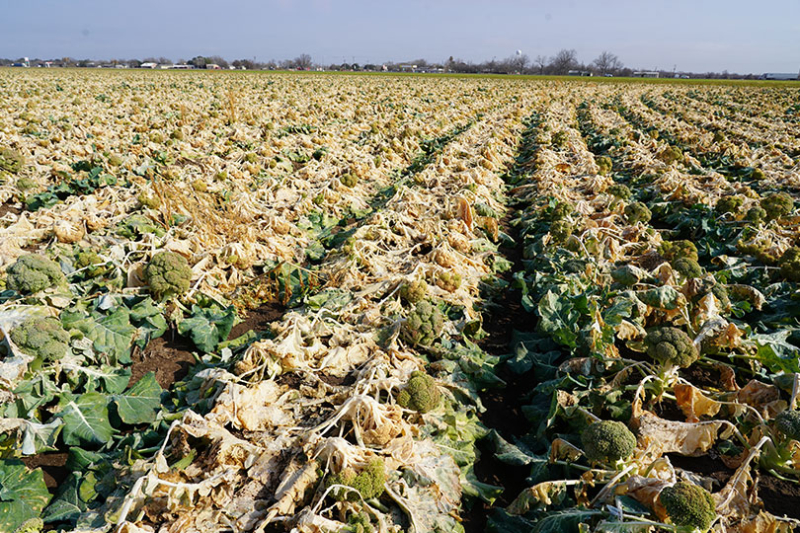Farmers nationwide have already received more than $4 billion through the Emergency Relief Program (ERP), representing nearly 67% of the more than $6 billion projected to be paid through this phase of the program. Eligible farmers in Texas have received $557.5 million in funding to date.
The U.S. Department of Agriculture (USDA) mailed out pre-filled applications in late May to farmers with crop insurance who suffered losses due to natural disasters in 2020 and 2021. Commodity and specialty crop producers have until July 22 to complete applications.
“Over the course of the past two years, natural disaster events in Texas have resulted in catastrophic production and property losses for our agricultural producers,” Kelly Adkins, state executive director for FSA in Texas, said. “Although these payments will not make these producers whole, they will help alleviate some of the financial stressors brought on by these severe and devastating weather events.”
USDA is implementing ERP as a two-phased program, with the first phase using existing claim data to provide relief expediently, and the second phase focusing on ensuring farmers not covered by other programs receive assistance. For phase one, USDA used crop insurance and Noninsured Crop Disaster Assistance Program (NAP) claim data.
Both ERP and the previously announced Emergency Livestock Relief Program (ELRP) are funded by the Extending Government Funding and Delivering Emergency Assistance Act, which President Biden signed into law in 2021. The law provided $10 billion to help agricultural producers impacted by wildfires, droughts, hurricanes, winter storms and other eligible disasters experienced during calendar years 2020 and 2021. Eligible livestock producers received ELRP payments totaling more than $590 million since the program was rolled out in late March. Livestock producers in Texas have received $61.2 million in ELRP payments to offset the impacts of extreme drought conditions.
Pre-Filled Applications
Eligible producers with eligible crop insurance claims have received pre-filled applications, which included eligibility requirements and payment calculations. Producers received a separate application form for each program year in which they experienced an eligible loss.
Producers should check with the Farm Service Agency (FSA) at their local USDA Service Center to confirm eligibility and to ensure that all required farm program participation, adjusted gross income and conservation compliance forms are on file. Producers who have previously participated in FSA programs likely have these required forms already on file.
ERP provisions allow for a higher payment percentage for historically underserved producers, including beginning, limited resource, socially disadvantaged and military veteran producers. To qualify for the higher payment rate, individuals must have a Form CCC-860, Socially Disadvantaged, Limited Resource, Beginning and Veteran Farmer or Rancher Certification on file.
To receive a payment, producers must complete and submit their forms by the July 22 deadline. Once the completed ERP application for payment is submitted to and signed by the FSA, producers enrolled in direct deposit should look for their payment within three business days.
Additional assistance through phase one
FSA will be sending pre-filled applications for about 9,000 producers nationwide with NAP coverage in mid-July.
The federal crop insurance data used to populate ERP phase one pre-filled applications included claim data on file with USDA’s Risk Management Agency (RMA) as of May 2, 2022. At that time, claim data for the Supplemental Coverage Option (SCO), Enhanced Coverage Option (ECO), Stacked Income Protection Plan (STAX), Margin Protection Plan (MP) or Area Risk Protection Insurance (ARPI) were not complete, so crop/units including these coverage options were not included in the pre-filled ERP application form. In late summer 2022, updated claim information will be used to generate a second pre-filled application for those crop/units on file with RMA not included in the first mailing.
More information
ERP covers losses to crops, trees, bushes and vines due to a qualifying natural disaster event in calendar years 2020 and 2021. Eligible crops include all crops for which crop insurance or NAP coverage was available, except for crops intended for grazing. Qualifying natural disaster events include wildfires, hurricanes, floods, derechos, excessive heat, winter storms, freeze (including a polar vortex), smoke exposure, excessive moisture, qualifying drought and related conditions.
All producers who receive ERP phase one payments are statutorily required to purchase crop insurance or NAP coverage where crop insurance is not available for the next two available crop years.
Producers should contact their local Service Center if they have questions. Additionally, other resources include:
The second phase of both ERP and ELRP will fill gaps and provide assistance to producers who did not participate in or receive payments through the existing programs that are being leveraged for phase one implementation. Through proactive communication and outreach, USDA will keep farmers and stakeholders informed as program details are made available.

